DAIKIN RWEYQ72PTJU, RWEYQ84PTJU, RWEYQ144PTJU, RWEYQ168PTJU, RWEYQ216PTJU INSTALLATION MANUAL
...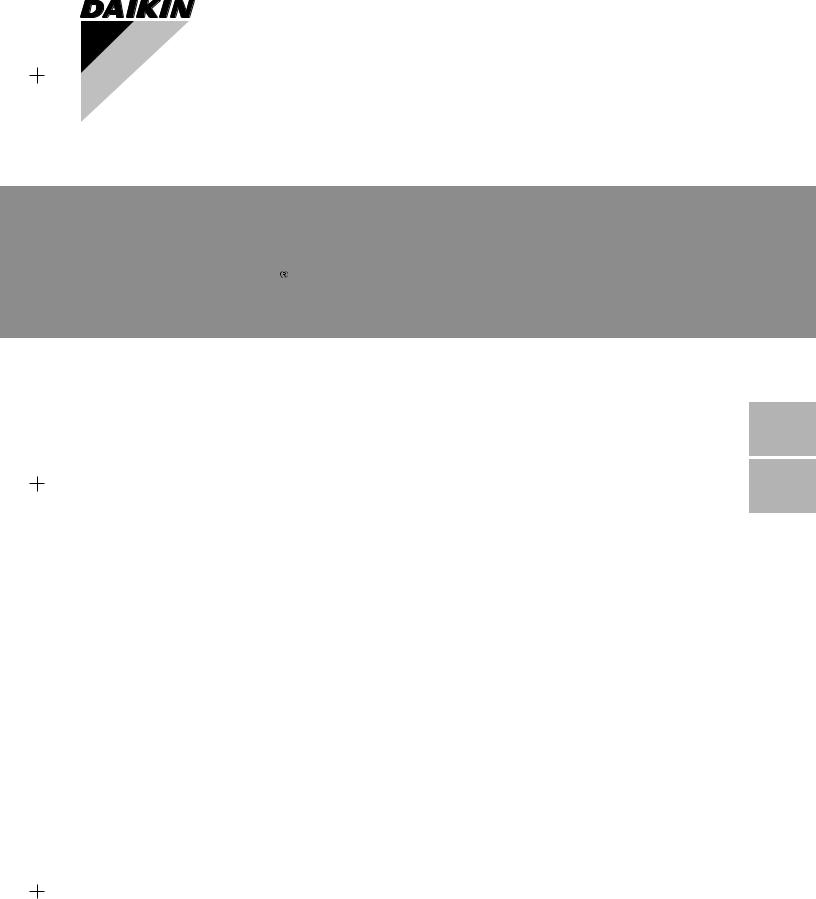
INSTALLATION MANUAL



 System air conditioner
System air conditioner
MODEL |
English |
|
|
RWEYQ72PTJU
RWEYQ84PTJU
RWEYQ144PTJU
RWEYQ168PTJU
RWEYQ216PTJU
RWEYQ252PTJU
Français
Español
Read these instructions carefully before installation.
Keep this manual in a handy place for future reference.
This manual should be left with the equipment owner.
Lire soigneusement ces instructions avant I’installation. Concerver ce manuel à portée de main pour référence ultérieure. Ce manuel doit être donné au propriétaire de l’équipement.
Lea cuidadosamente estas instrucciones antes de instalar.
Guarde este manual en un lugar a mano para leer en caso de tener alguna duda. Este manual debe permanecer con el propietario del equipo.
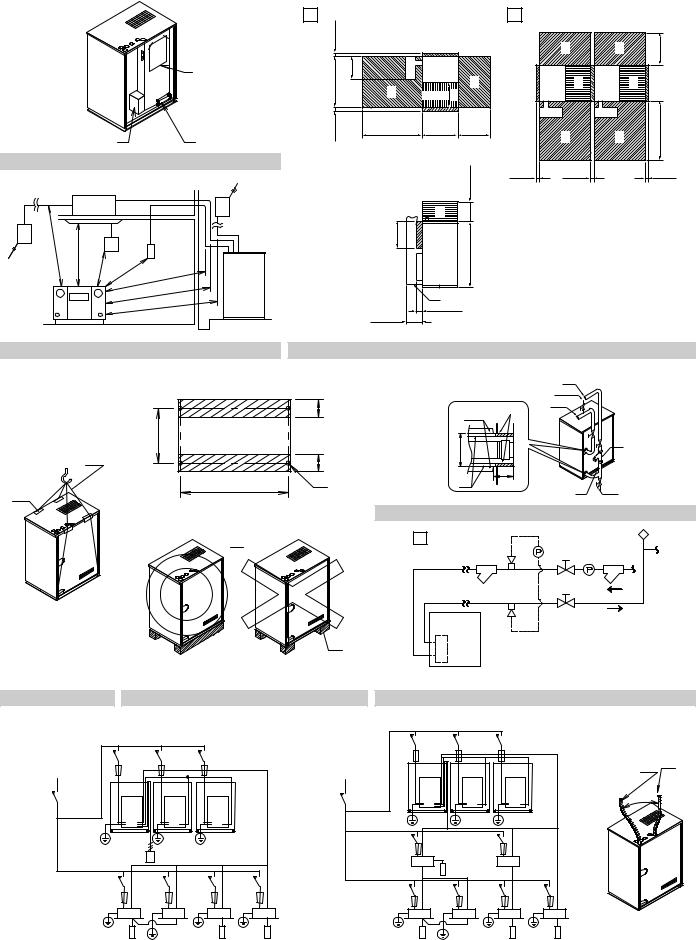
figure 1
1
2
60 |
40 |
≥ |
|
|
≥ |
40 ≥
5
figure 3
3
3
≥40
4
≥60 ≥60 ≥60
1
2
1 |
≥13/16 |
|
|
|
|
|
|
|
|
|
|
|
11/16 |
3/4 |
8 |
|
|
|
≤13- |
|
|
||
[3] |
|
|
7 |
||
30- |
|
6 |
≥15-3/8 9 |
|
|
|
|
|
|||
|
≥13/16 |
|
≥35-7/16 |
21-5/8 ≥19-11/16 |
|
|
|
|
|||
|
|
|
|
|
≥11-13/16 |
2 |
|
|
|
9 |
|
|
|
|
|
|
|
|
|
|
-3/4 |
|
3/8 |
|
|
|
13≥ |
|
|
|
|
|
[4] |
5 |
|
|
|
|
|
- |
|
|
|
|
|
|
39 |
|
|
|
|
8 |
|
≥3-15/16
≤9-13/16
(in.)
figure 2
2
|
7 |
7 |
-11/16 |
|
|
|
≥19 |
|
9 |
|
9 |
|
8 |
8 |
35-7/16 |
|
6 |
6 |
|
|
|
|
≥ |
≥13/16 |
≥13/16 |
|
≥13/16 |
10
|
|
|
|
|
|
|
3 |
|
|
|
|
1/8-3 |
|
|
|
4 |
1 |
|
|
|
|
|
|
12 |
2 |
|
|
||
|
|
|
|
14 |
|
|
|||
|
|
|
|
|
|
|
|
||
|
|
|
|
|
|
|
|
|
|
|
-3/4 |
|
|
|
|
|
|
|
9 |
2 |
15 |
1/8 |
|
13 |
6 |
8 |
|
|
|
|
|
|
|
||||||
|
|
|
|
|
|
|
|
||
|
|
3- |
|
|
|
60 |
|
|
|
|
|
3 |
|
|
7 |
5 |
|
|
|
1 |
29-5/16 |
|
|
|
11 |
10 |
|||
[1] |
|
|
|
|
|
|
|
|
|
|
|
figure 6 |
|
|
|
|
|
|
|
|
|
|
|
|
|
|
|
|
|
|
2 |
|
1 |
|
|
4 |
5 |
|
7 |
|
|
|
|
|
3 |
|
|
6 |
|
|
|
|
2 |
|
|
|
|
||
|
|
|
|
|
|
|
|
|
|
|
|
|
8 |
|
|
|
|
|
|
|
|
|
|
|
|
9 |
|
|
|
|
|
4 |
|
10 |
|
|
|
|
|
|
|
|
|
|
|
|
|
|
|
|
|
|
|
11 |
|
|
|
|
|
figure 4 |
figure 5 |
|
figure 7 |
|
|
|
|
|
|
[Heat pump system] |
|
|
3 |
1 |
4 |
2 |
7 |
|
10 |
|
5 |
|
4 |
|
9 |
|
6 |
[Heat recovery system] |
3 |
|
|
|
|
|
|
||
|
4 |
1 |
2 |
|
1 |
7 |
|||
|
||||
|
|
|||
2 |
|
3 |
|
|
|
8 |
|
|
|
|
10 |
|
|
|
|
5 |
|
|
|
|
4 |
|
|
|
|
9 |
|
|
|
|
6 |
|
|
figure 8 |
|
figure 9 |
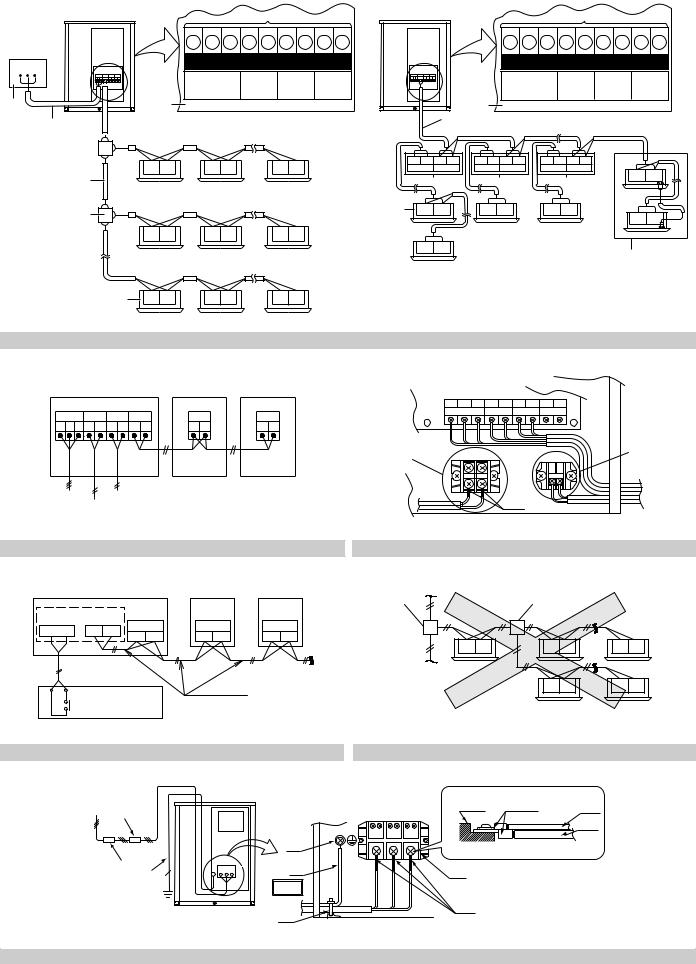
[Heat pump system] |
|
|
|
|
7 |
|
|
[Heat recovery system] |
|
|
|
|
|
|
7 |
|
|
|
|||||
|
|
|
|
|
|
|
|
|
|
|
|
|
|
|
|
|
|
|
|
|
|
||
|
|
|
A |
B |
C |
F1 F2 |
F1 F2 |
Q1 Q2 |
|
|
|
|
|
A |
B |
C |
F1 |
F2 |
F1 F2 |
Q1 |
Q2 |
||
A B C |
A1P |
|
|
|
|
|
|
|
|
A1P |
|
|
|
|
|
|
|
|
|
|
|
|
|
|
A B C F1 F2 F1 F2 Q1 Q2 |
|
|
|
|
|
|
|
A B C F1 F2 F1 F2 Q1 Q2 |
|
|
|
|
|
|
|
|
|
|
|
|
||
|
|
|
C/H SELECTOR |
TO IN/D UNIT |
TO OUT/D UNIT |
TO MULTI UNIT |
|
|
|
|
|
C/H SELECTOR |
TO IN/D UNIT |
TO OUT/D UNIT |
TO MULTI UNIT |
||||||||
1 |
|
|
2 |
|
|
|
|
|
|
|
|
|
2 |
|
|
|
|
|
|
|
|
|
|
|
3 |
|
|
|
|
|
|
|
|
|
4 |
|
|
|
|
|
|
|
|
|
|
|
|
|
|
|
|
|
|
|
|
|
|
|
|
|
|
|
|
|
|
|
|
|
|
|
|
|
|
|
|
|
|
|
|
|
F1 |
F2 |
F1 |
F2 |
F1 |
F2 |
F1 |
F2 |
F1 |
F2 |
F1 |
F2 |
|
|
|
|
|
F1 |
F2 |
F1 |
F2 |
|
F1 |
F2 |
IN/D |
OUT/D.BS |
IN/D |
OUT/D.BS |
IN/D |
OUT/D.BS |
|
F1 |
F2 |
||||||
|
4 |
|
|
|
|
|
|
|
|
|
8 |
|
|
|
9 |
|
|
10 |
|
|
|||
|
|
|
|
|
|
|
|
|
|
|
|
|
|
|
|
|
|
|
|||||
|
5 |
|
|
|
|
|
|
|
6 |
F1 |
F2 |
|
F1 |
F2 |
|
F1 |
|
F2 |
|
|
|
|
|
|
|
|
|
|
|
|
|
|
|
|
|
|
|
|
|
|
|
|
|
|
F1 |
F2 |
|
|
|
|
|
|
|
|
|
|
|
|
|
|
|
|
|
|
|
|
|
|
|
||
|
|
F1 |
F2 |
F1 |
F2 |
|
F1 |
F2 |
|
|
|
|
|
|
|
|
|
|
|
|
|
|
|
|
|
|
|
|
|
|
|
|
|
F1 |
F2 |
|
|
|
|
|
|
|
|
|
11 |
|
|
|
|
|
|
|
|
|
|
|
|
|
|
|
|
|
|
|
|
|
|
|
|
||
|
6 |
F1 |
F2 |
F1 |
F2 |
|
F1 |
F2 |
|
|
|
|
|
|
|
|
|
|
|
|
|
|
|
figure 10
|
1 |
|
2 |
3 |
|
A1P |
|
|
|
4 |
5 |
6 |
6 |
6 |
A B C F1 F2 F1 F2 Q1 Q2 |
Q1 Q2 |
Q1 Q2 |
||
7 9
8
figure 11
|
1 |
|
|
|
2 |
3 |
|
|
|
4 |
TO OUT/D UNIT |
TO OUT/D UNIT |
TO OUT/D UNIT |
||||
LOW NOISE |
F1 F2 |
|||||||
F1 |
F2 |
F1 |
F2 |
F1 |
F2 |
|||
|
|
|||||||
|
|
|
|
|
|
6 |
|
|
5 |
7 |
|
figure 13
1 2
|
|
7 |
4 |
3 |
9 |
|
|
|
|
|
10 |
|
|
8 |
|
A1P |
X1M |
2 |
|
|
|
|
|
|
||
|
A B C F 1 F 2 F 1 F 2 Q 1 Q 2 |
|
|||
1 |
X2M |
X3M |
4 |
||
|
|
|
|||
|
1 |
2 |
3 |
4 |
|
|
|
|
|
||
|
|
|
3 |
|
|
figure 12
1 |
2 |
|
F1 F2 |
F1 F2 |
F1 F2 |
|
F1 F2 |
F1 F2 |
figure 14
12 |
13 |
14 |
11 |
|
15 |
6 |
|
|
5 |
|
|
figure 15
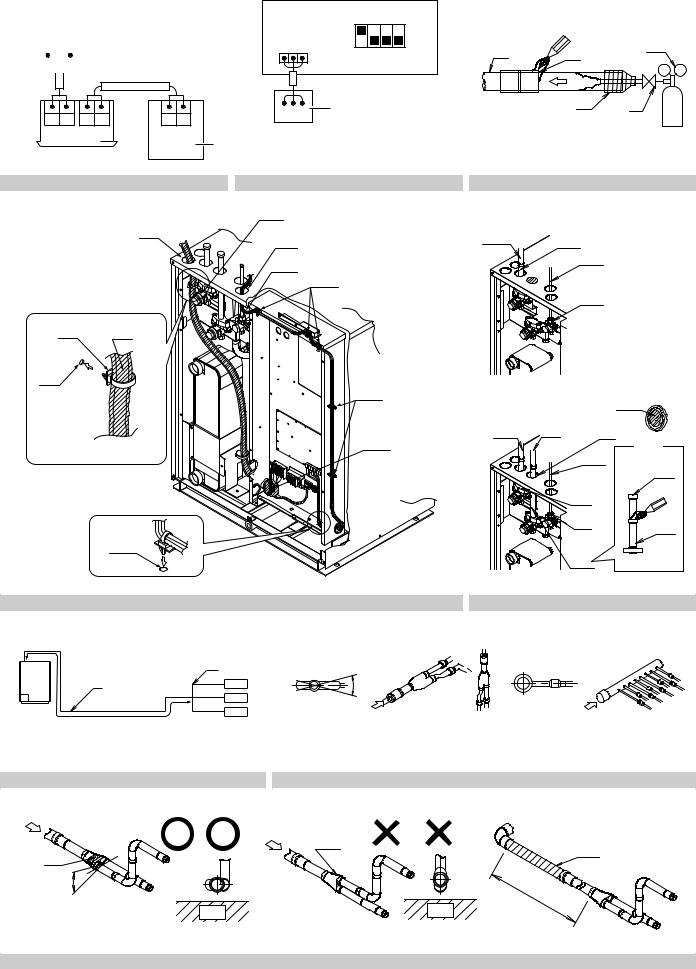
|
|
A1P |
|
|
O |
|
|
|
|
|
|
|
|
|
|
|||||
|
|
|
|
U |
|
|
|
|
|
|
|
|
|
|
||||||
|
|
|
|
|
|
|
|
|
T |
|
|
|
|
|
|
|
|
|
|
|
|
TO IN/D |
ON |
|
|
|
|
|
|
|
|
|
|
||||||||
|
|
UNIT |
|
|
|
|
|
|
|
|
|
|
|
|
DS1 |
|||||
|
|
OFF |
|
|
|
|
|
|
|
|
|
|
|
|
||||||
|
F1 F2 |
|
|
|
|
|
|
|
|
|
|
|
|
|
||||||
|
|
|
|
|
|
|
|
|
|
|
|
|
|
|||||||
|
|
|
|
|
|
|
1 |
|
2 |
|
3 |
|
4 |
|
|
|||||
|
|
|
|
|
|
|
|
|
|
|
|
|||||||||
|
|
|
|
|
|
|
|
|
I |
|
|
|
|
|
|
|
|
|
|
|
|
|
|
|
|
|
|
|
|
N |
|
|
|
|
|
|
|
|
|
|
|
A1P |
O |
|
|
|
|
|
|
|
U |
|
|
|
|
|
|
||
|
T |
|
|
|
|
|
|
|
|
ON |
|
|
|
DS1 |
|
|
|
|
|
|
|
|
|
|
||
A B C |
OFF |
|
|
|
|
|
6 |
|
1 |
2 |
3 |
4 |
1 |
2 |
|||
|
|
|||||||
|
I |
|
|
|
|
|
|
|
|
N |
|
|
|
|
|
|
|
|
A B C |
1 |
F1 F2 |
P1 P2 |
P1 P2 |
|
|
|
1 |
|
figure 16 |
|
figure 17 |
|
|
|
2 |
|
|
|
1 |
|
|
|
7 |
|
|
|
8 |
|
|
|
|
9 |
5 |
|
4 |
|
3 |
|
|
|
10
11
6
figure 19
4
3
4 5
3
figure 18
[Heat pump system]
1 3
2 |
4 |
|
|
|
5 |
6
[Heat recovery system] |
10 |
|
7 |
8 |
9 |
|
4 |
[13] |
|
14 |
|
|
|
|
|
11 |
15 |
|
5 |
16 |
|
|
|
|
12 |
17 |
figure 20
1 |
2 |
1 |
2 |
3 |
|
|
|
B |
|
|
|
5 |
A |
|
|
3 |
|
|
|
|
|
|
|
|
|
|
[A-arrow view] |
|
[B-arrow view] |
figure 21 |
|
figure 22 |
|
|
(Fig. A) |
|
(Fig. B) |
|
(Fig. C) |
C |
2 |
1 |
|
5 |
1 |
D |
|
||
|
|
|
||
≤ ±15 |
|
|
|
|
|
3 |
|
3 |
4 |
|
[C-arrow view] |
|
[D-arrow view] |
|
figure 23

[Heat pump system]
1
R410A
3
4
2
5
[Heat recovery system]
1
R410A
3
4
2
5
11 |
|
10 |
10 |
9 |
12 |
|
|
7 |
|
16 |
15 |
|
|
6 |
18 |
|
|
|
14 |
13 |
10 |
10 |
|
9 |
12 |
|
|
7 |
|
8
|
15 |
|
17 |
6 |
18 |
|
figure 24
4 |
[Heat pump system] |
|
|
3 |
|
5 |
|
2 |
1 |
||
|
|||
5 |
|
|
|
|
2 |
3 |
|
|
6 |
||
|
|
||
|
4 |
|
|
1 |
|
|
[Heat recovery system] |
1 |
2 |
|
|
|
|
|
|
|
|
1 |
|
|
|
2 |
3 |
|
|
|
|
|
|
|
|
|
4 |
5 |
4 |
3 |
figure 25 |
|
figure 26 |
|
figure 27 |
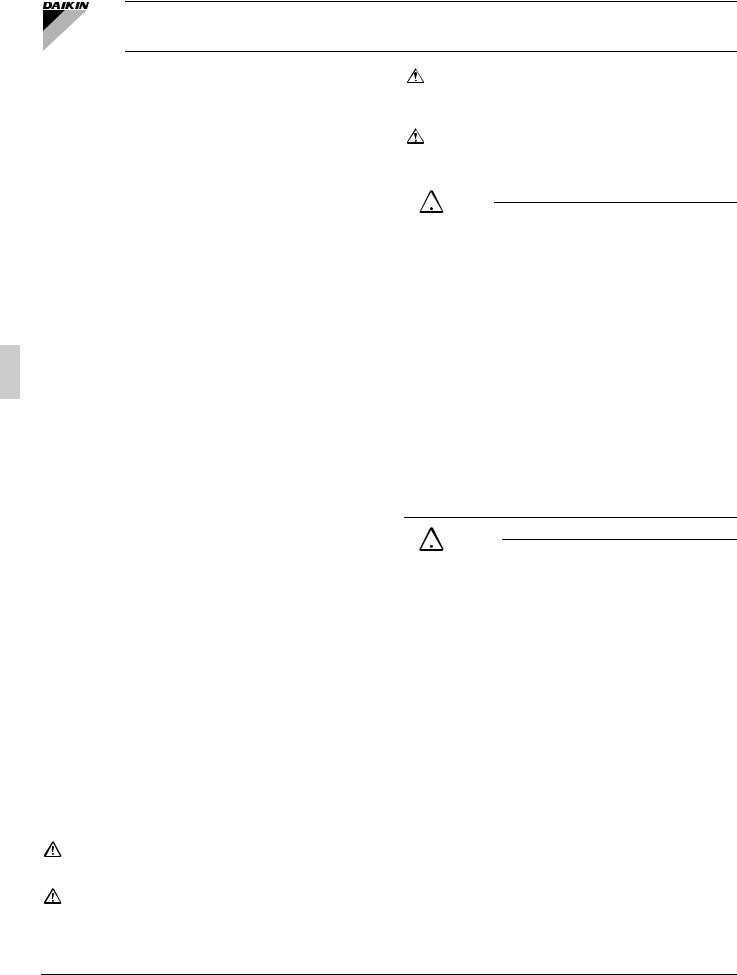
RWEYQ72PTJU |
RWEYQ168PTJU |
|
|
|
RWEYQ84PTJU |
RWEYQ216PTJU |
VRV-WIII System air conditioner |
Installation manual |
|
RWEYQ144PTJU |
RWEYQ252PTJU |
|||
|
|
CONTENTS |
|
|
1. |
SAFETY CONSIDERATIONS...................................................... |
1 |
2. |
INTRODUCTION.......................................................................... |
3 |
|
2-1. Combination .......................................................................... |
3 |
|
2-2. Standard operation limit ........................................................ |
3 |
|
2-3. Standard supplied accessories ............................................. |
3 |
|
2-4. Option accessory .................................................................. |
3 |
|
2-5. Technical specifications (1)................................................... |
4 |
|
2-6. Electrical specifications ......................................................... |
4 |
3. |
SELECTION OF LOCATION ....................................................... |
5 |
4. |
INSPECTING AND HANDLING THE UNIT ................................. |
5 |
5. |
UNPACKING AND PLACING THE UNIT..................................... |
5 |
6. |
WATER PIPING WORK............................................................... |
6 |
7. |
HANDLING OF THE BRAZED PLATE TYPE HEAT |
|
|
EXCHANGER .............................................................................. |
6 |
|
7-1. When designing the equipment ............................................ |
6 |
|
7-2. Before starting a test run....................................................... |
6 |
|
7-3. Daily service and maintenance ............................................. |
7 |
|
7-4. Water quality ......................................................................... |
7 |
|
7-5. Maintenance of plate type heat exchanger ........................... |
7 |
8. |
FIELD WIRING............................................................................. |
8 |
|
8-1. Optional parts........................................................................ |
8 |
|
8-2. Power circuit and cable requirements ................................... |
8 |
|
8-3. General ................................................................................. |
8 |
|
8-4. Examples .............................................................................. |
8 |
|
8-5. In case of a local setting ..................................................... |
10 |
9. |
REFRIGERANT PIPING ............................................................ |
11 |
|
9-1. Selection of piping material................................................. |
11 |
|
9-2. Protection against contamination when installing pipes........ |
11 |
|
9-3. Pipe connection .................................................................. |
11 |
|
9-4. Connecting the refrigerant piping ........................................ |
12 |
|
9-5. Example of connection........................................................ |
13 |
|
9-6. Air tight test and vacuum drying.......................................... |
14 |
|
9-7. Pipe insulation..................................................................... |
14 |
|
9-8. Checking of device and installation conditions.................... |
14 |
|
9-9. Additional refrigerant charge ............................................... |
14 |
|
9-10.Stop valve operation procedure ......................................... |
15 |
10. |
CHECKS AFTER INSTALLATION............................................. |
16 |
11. |
TEST RUN ................................................................................. |
16 |
|
11-1.Air discharge ...................................................................... |
16 |
|
11-2.Before turn on the power supply ........................................ |
16 |
|
11-3.Check operation................................................................. |
16 |
|
11-4.Check of normal operation................................................. |
17 |
12. |
CAUTION FOR REFRIGERANT LEAKS ................................... |
17 |
1.SAFETY CONSIDERATIONS
Read these SAFETY CONSIDERATIONS for Installation carefully before installing air conditioning equipment. After completing the installation, make sure that the unit operates properly during the startup operation.
Instruct the customer on how to operate and maintain the unit. Inform customers that they should store this Installation Manual with the Operation Manual for future reference.
Always use a licensed installer or contractor to install this product. Improper installation can result in water or refrigerant leakage, electrical shock, fire, or explosion.
Meanings of DANGER, WARNING, CAUTION, and NOTE Symbols:
DANGER .................... |
Indicates an imminently hazardous situa- |
|
tion which, if not avoided, will result in |
|
death or serious injury. |
WARNING................... |
Indicates a potentially hazardous situation |
|
which, if not avoided, could result in death |
|
or serious injury. |
CAUTION .................... |
Indicates a potentially hazardous situation |
|
which, if not avoided, may result in minor or |
|
moderate injury. It may also be used to |
|
alert against unsafe practices. |
NOTE........................... |
Indicates situations that may result in |
|
equipment or property-damage accidents |
|
only. |

 DANGER
DANGER
•Refrigerant gas is heavier than air and replaces oxygen. A massive leak can lead to oxygen depletion, especially in basements, and an asphyxiation hazard could occur leading to serious injury or death.
•Do not ground units to water pipes, gas pipes, telephone wires, or lightning rods as incomplete grounding can cause a severe shock hazard resulting in severe injury or death. Additionally, grounding to gas pipes could cause a gas leak and potential explosion causing severe injury or death.
•If refrigerant gas leaks during installation, ventilate the area immediately. Refrigerant gas may produce toxic gas if it comes in contact with fire. Exposure to this gas could cause severe injury or death.
•After completing the installation work, check that the refrigerant gas does not leak throughout the system.
•Do not install unit in an area where flammable materials are present due to risk of explosions that can cause serious injury or death.
•Safely dispose all packing and transportation materials in accordance with federal/state/local laws or ordinances. Packing materials such as nails and other metal or wood parts, including plastic packing materials used for transportation may cause injuries or death by suffocation.

 WARNING
WARNING
•Only qualified personnel must carry out the installation work. Installation must be done in accordance with this installation manual. Improper installation may result in water leakage, electric shock, or fire.
•When installing the unit in a small room, take measures to keep the refrigerant concentration from exceeding allowable safety limits. Excessive refrigerant leaks, in the event of an accident in a closed ambient space, can lead to oxygen deficiency.
•Use only specified accessories and parts for installation work. Failure to use specified parts may result in water leakage, electric shocks, fire, or the unit falling.
•Install the air conditioner on a foundation strong enough that it can withstand the weight of the unit. A foundation of insufficient strength may result in the unit falling and causing injuries.
•Take into account strong winds, typhoons, or earthquakes when installing. Improper installation may result in the unit falling and causing accidents.
•Make sure that a separate power supply circuit is provided for this unit and that all electrical work is carried out by qualified personnel according to local state, and national regulations. An insufficient power supply capacity or improper electrical construction may lead to electric shocks or fire.
•Make sure that all wiring is secured, that specified wires are used, and that no external forces act on the terminal connections or wires. Improper connections or installation may result in fire.
1 |
English |

•When wiring, position the wires so that the terminal box lid can be securely fastened. Improper positioning of the terminal box lid may result in electric shocks, fire, or the terminals overheating.
•Before touching electrical parts, turn off the unit.
•Be sure to install a ground fault circuit interrupter if one is not already available. This helps prevent electrical shocks or fire.
•Securely fasten the outside unit terminal cover (panel). If the terminal cover/panel is not installed properly, dust or water may enter the outside unit causing fire or electric shock.
•When installing or relocating the system, keep the refrigerant circuit free from substances other than the specified refrigerant (R-410A) such as air. Any presence of air or other foreign substance in the refrigerant circuit can cause an abnormal pressure rise or rupture, resulting in injury.
•Do not change the setting of the protection devices. If the pressure switch, thermal switch, or other protection device is shorted and operated forcibly, or parts other than those specified by Daikin are used, fire or explosion may occur.

 CAUTION
CAUTION
•Do not touch the switch with wet fingers. Touching a switch with wet fingers can cause electric shock.
•Do not allow children to play on or around the unit to prevent injury.
•Do not touch the refrigerant pipes during and immediately after operation as the refrigerant pipes may be hot or cold, depending on the condition of the refrigerant flowing through the refrigerant piping, compressor, and other refrigerant cycle parts. Your hands may suffer burns or frostbite if you touch the refrigerant pipes. To avoid injury, give the pipes time to return to normal temperature or, if you must touch them, be sure to wear proper gloves.
•Heat exchanger fins are sharp enough to cut.
To avoid injury wear glove or cover the fins when working around them.
•Install drain piping to proper drainage. Improper drain piping may result in water leakage and property damage.
•Insulate piping to prevent condensation.
•Be careful when transporting the product.
•Do not turn off the power immediately after stopping operation. Always wait for at least 5 minutes before turning off the power. Otherwise, water leakage may occur.
•Do not use a charging cylinder. Using a charging cylinder may cause the refrigerant to deteriorate.
•Refrigerant R-410A in the system must be kept clean, dry, and tight.
(a)Clean and Dry -- Foreign materials (including mineral oils such as SUNISO oil or moisture) should be prevented from getting into the system.
(b)Tight -- R-410A does not contain any chlorine, does not destroy the ozone layer, and does not reduce the earth’s protection again harmful ultraviolet radiation. R-410A can contribute to the greenhouse effect if it is released. Therefore take proper measures to check for the tightness of the refrigerant piping installation. Read the chapter Refrigerant Piping and follow the procedures.
•Since R-410A is a blend, the required additional refrigerant must be charged in its liquid state. If the refrigerant is charged in a state of gas, its composition can change and the system will not work properly.
•The indoor unit is for R-410A. See the catalog for indoor models that can be connected. Normal operation is not possible when connected to other units.
•Remote controller (wireless kit) transmitting distance can be shorter than expected in rooms with electronic fluorescent lamps (inverter or rapid start types). Install the indoor unit far away from fluorescent lamps as much as possible.
•Indoor units are for indoor installation only. Outdoor units can be installed either outdoors or indoors.
•Do not install the air conditioner in the following locations:
(a)Where a mineral oil mist or oil spray or vapor is produced, for example, in a kitchen.
Plastic parts may deteriorate and fall off or result in water leakage.
(b)Where corrosive gas, such as sulfurous acid gas, is produced.
Corroding copper pipes or soldered parts may result in refrigerant leakage.
(c)Near machinery emitting electromagnetic waves. Electromagnetic waves may disturb the operation of the control system and cause the unit to malfunction.
(d)Where flammable gas may leak, where there is carbon fiber, or ignitable dust suspension in the air, or where volatile flammables such as thinner or gasoline are handled. Operating the unit in such conditions can cause a fire.
•Take adequate measures to prevent the outside unit from being used as a shelter by small animals. Small animals making contact with electrical parts can cause malfunctions, smoke, or fire. Instruct the customer to keep the area around the unit clean.

 NOTE
NOTE
•Install the power supply and control wires for the indoor and outdoor units at least 3.5 feet away from televisions or radios to prevent image interference or noise. Depending on the radio waves, a distance of 3.5 feet may not be sufficient to eliminate the noise.
•Dismantling the unit, treatment of the refrigerant, oil and additional parts must be done in accordance with the relevant local, state, and national regulations.
•Do not use the following tools that are used with conventional refrigerants: gauge manifold, charge hose, gas leak detector, reverse flow check valve, refrigerant charge base, vacuum gauge, or refrigerant recovery equipment.
•If the conventional refrigerant and refrigerator oil are mixed in R-410A, the refrigerant may deteriorate.
•This air conditioner is an appliance that should not be accessible to the general public.
•The wall thickness of field-installed pipes should be selected in accordance with the relevant local, state, and national regulations.
English |
2 |
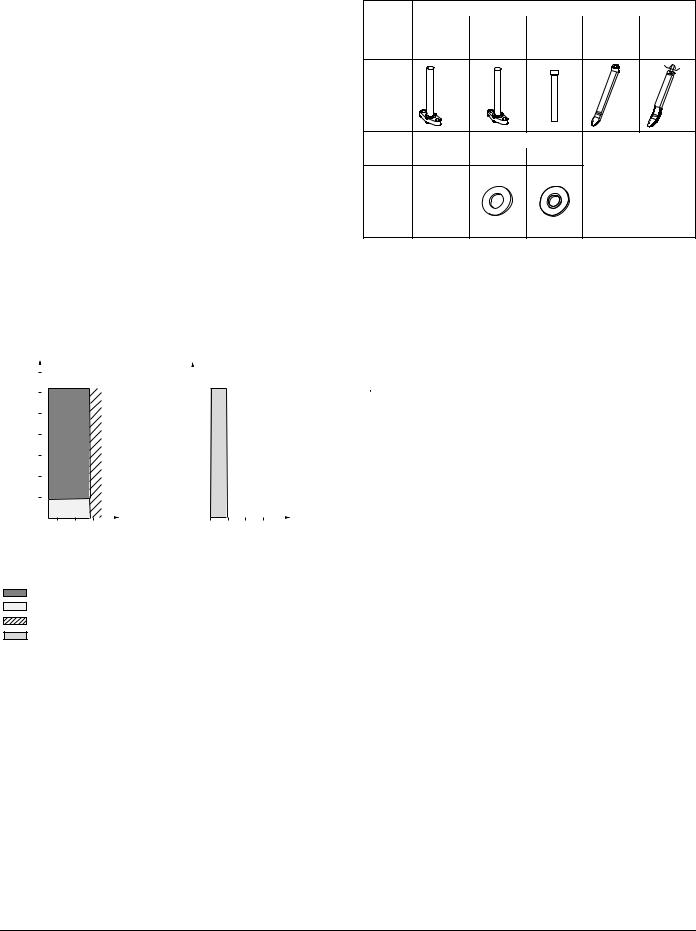
2.INTRODUCTION
This installation manual concerns VRV inverters of the Daikin RWEYQ-P series. These units are designed for indoor installation and used for cooling and heatpump applications.
The RWEYQ-P units can be combined with Daikin VRV series indoor units for air conditioning purposes.
The present installation manual describes the procedures for unpacking, installing and connecting the RWEYQ-P units. Installation of the indoor units is not described in this manual. Always refer to the installation manual supplied with these units for their installation.
2-1 Combination
The indoor units can be installed in the following range.
•Always use appropriate indoor units compatible with R410A. To lean which models of indoor units are compatible with R410A, refer to the product catalogs.
•Total capacity/quantity of indoor units
Outside unit |
Total capacity index of indoor units |
Total quantity of indoor units |
|
RWEYQ72PTJU................ |
36 |
~ 93.5 |
12 units |
RWEYQ84PTJU................ |
42 |
~ 109 |
14 units |
RWEYQ144PTJU |
..............72 |
~ 187 |
20 units |
RWEYQ168PTJU |
..............84 |
~ 218 |
20 units |
RWEYQ216PTJU |
............108 |
~ 280 |
22 units |
RWEYQ252PTJU |
............126 |
~ 327.5 |
32 units |
2-2 Standard operation limit
The figures below assume following operating conditions for indoor and
|
outside units: |
|
|
|
|
|
|
|
|
|
|
|
|
|
|
|
|
|||
|
|
Equivalent pipe length |
...................................................... |
|
|
|
|
|
|
|
|
25 ft |
||||||||
|
|
Level difference |
.................................................................. |
|
|
|
|
|
|
|
|
|
|
|
|
|
0 ft |
|||
|
Cooling |
|
|
|
|
|
|
Heating |
|
|
|
|
|
|
|
|||||
|
|
A |
|
|
|
|
|
|
|
A |
|
|
|
|
|
|
|
|||
|
120 |
|
|
|
|
|
|
|
120 |
|
|
|
|
|
|
|
|
|
|
|
|
|
|
|
|
|
|
|
|
|
|
|
|
|
|
|
|
||||
|
110 |
|
|
|
|
|
|
|
110 |
|
|
|
|
|
|
|
|
|
|
|
|
|
|
|
|
|
|
|
|
|
|
|
|
|
|
|
|
|
|||
|
|
|
|
|
|
|
|
|
|
|
|
|
|
|
|
|
||||
|
100 |
|
|
|
|
|
|
|
100 |
|
|
|
|
|
|
|
|
|
|
|
|
90 |
|
|
|
|
|
|
|
90 |
|
|
|
|
|
|
|
|
|
|
|
|
|
|
|
|
|
|
|
|
|
|
|
|
|
|
|
|
||||
|
80 |
|
|
|
|
|
|
|
80 |
|
|
|
|
|
|
|
|
|
|
|
|
70 |
|
|
|
|
|
|
|
70 |
|
|
|
|
|
|
|
|
|
|
|
|
|
|
|
|
|
|
|
|
|
|
|
|
|
|
|
|
||||
|
60 |
|
|
|
|
|
|
|
60 |
|
|
|
|
|
|
|
|
|
|
|
|
50 |
|
|
|
|
|
|
|
50 |
|
|
|
|
|
|
|
|
|
|
|
|
|
|
|
|
|
|
|
|
|
|
|
|
|
|
|
|
||||
|
50 |
60 |
70 |
80 |
90 |
|
50 |
60 |
70 |
80 |
90 |
|
||||||||
|
|
|
|
|
|
|
|
B |
|
|
|
|
|
|
|
|
|
|
C |
|
|
|
|
|
|
|
|
|
|
|
|
|
|
|
|
|
|
|
|
|
|
AInlet water temperature (°F)
BIndoor temperature (°FWB)
CIndoor temperature (°FDB)
Range for continuous operation
Range for operation
Range for pull down operation
Range for warming up operation
•Operation range of water volume is 13.5~39.5 gpm
•The unit is designed for the following operation range: Water temperature: 67~95°F
Water volume: 16 gpm or more
•During cooling operation when the outside temperature is very low, it is possible that the thermostat switches off automatically in order to protect the unit from freezing.
•Hold ambient temperature at 35~95°F
Heat-release from the unit: 0.64 kW / hour (Model 72, 84). It is therefore recommended to always ventilate the room.
2-3 Standard supplied accessories
•Make sure that the following accessories are included. (Check by removing the front panel.)
|
|
|
Accessory pipes |
|
|
|
Name |
|
|
|
|
|
|
For discharge |
For suction |
For suction |
Clamp (A) |
Clamp (B) |
||
|
||||||
|
gas |
gas (1) |
gas (2) |
|||
|
|
|
||||
|
|
|
|
|
|
|
Quantity |
1 pc. |
1 pc. |
1 pc. |
7 pcs. |
2 pcs. |
(Note)
Shape
White Black
Name |
Strainer |
Conduit mounting plate |
|
|
|
|
|
Quantity |
1 pc. |
2 pcs. |
2 pcs. |
[Others]
• Installation manual
• Operation manual
Shape
(Refer to figure 1)
1.• Operation manual
•Installation manual
•Clamp (A)
•Clamp (B)
•Conduit mounting plate
2.Accessory pipes
•For discharge gas
•For suction gas (1)
•For suction gas (2)
3.Strainer
 NOTE
NOTE
The accessory pipe for discharge gas is used for the heat recovery system. (Not used for the heat pump system.)
2-4 Option accessory
To install the above outside units, the following optional parts are also required.
•Refrigerant branching kit
(For R410A only: Always use an appropriate kit dedicated for your system.)
Heat pump system
REFNET header |
KHRP26M22H |
KHRP26M33H |
KHRP26M72H |
KHRP26M73HU |
REFNET joint |
KHRP26M22T |
KHRP26M33T |
KHRP26M72TU |
KHRP26M73TU |
Heat recovery system......For 3-tube piping |
|
|||
|
|
|
|
|
REFNET header |
|
KHRP25M33H |
KHRP25M72H |
KHRP25M73HU |
REFNET joint |
KHRP25M22T |
KHRP25M33T |
KHRP25M72TU |
KHRP25M73TU |
Heat recovery system......For 2-tube piping |
|
|||
|
|
|
|
|
REFNET header |
KHRP26M22H |
KHRP26M33H |
KHRP26M72H |
KHRP26M73HU |
REFNET joint |
KHRP26M22T |
KHRP26M33T |
KHRP26M72TU |
KHRP26M73TU |
• Outside unit multi connection piping kit
(For R410A only: Always use an appropriate kit dedicated for your system.)
Number of outside units |
2 units |
3 units |
|
connected |
|||
|
|
||
Heat pump system |
BHFP22MA56U |
BHFP22MA84U |
|
Heat recovery system |
BHFP26MA56U |
BHFP26MA84U |
To select an optimum kit, refer to “9. REFRIGERANT PIPING”
3 |
English |
